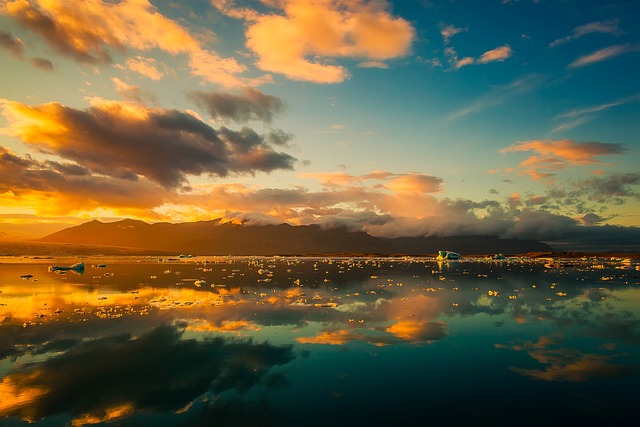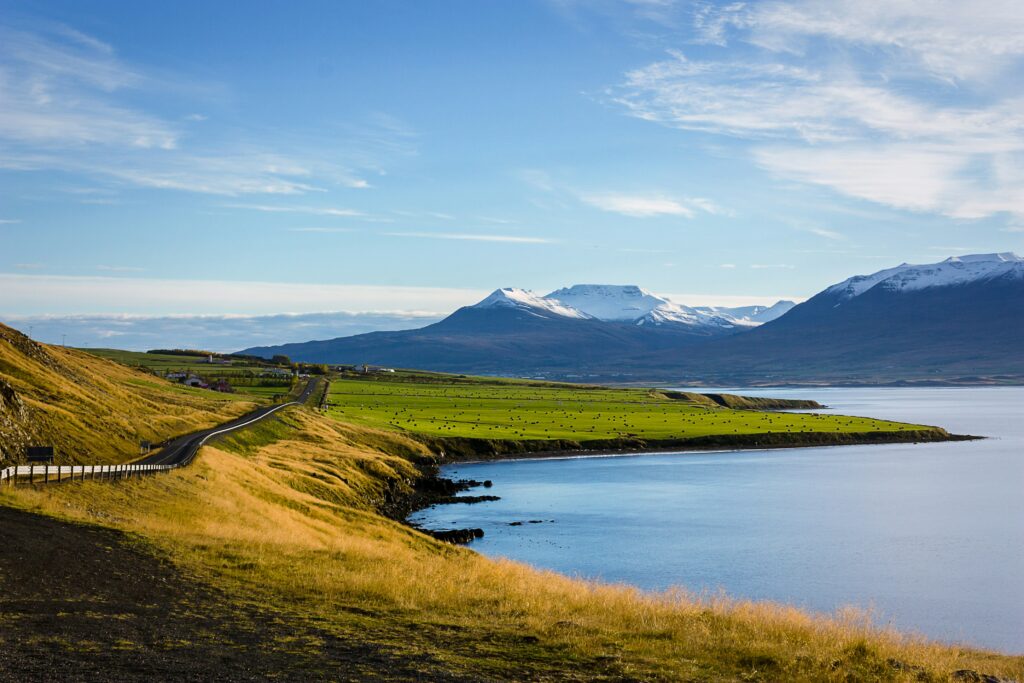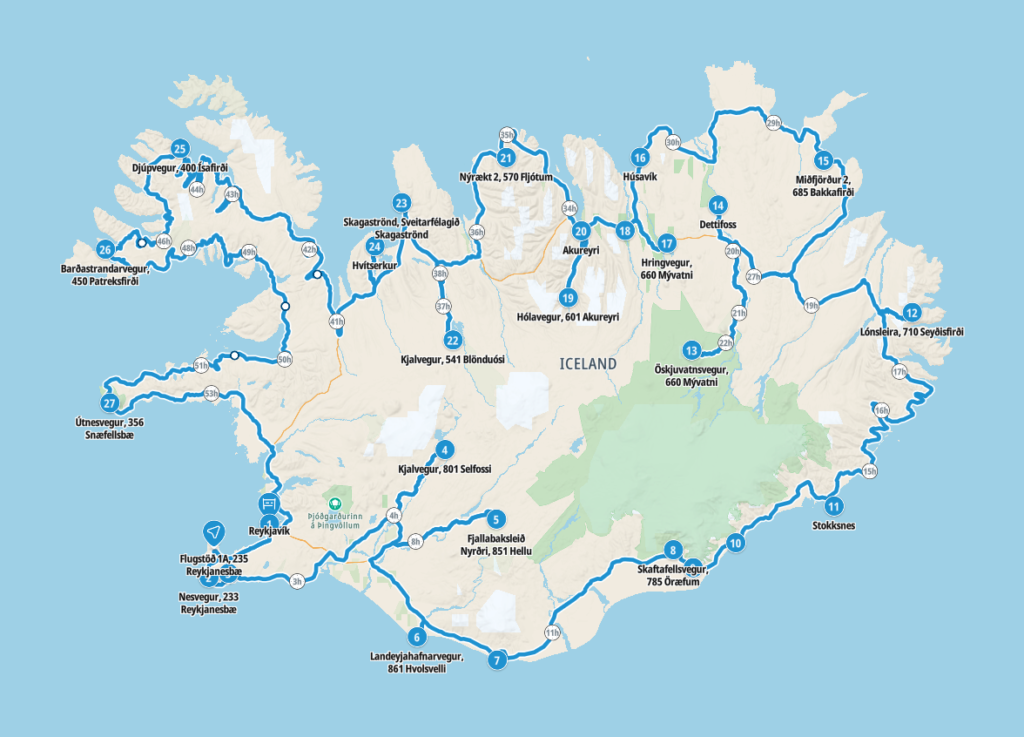Iceland / Ísland – Let’s explore here
What’s it like in Iceland?
Iceland is a stunning island country in the Artic Ocean, the centre of which consists of active volcanoes, lava fields, geysers, mountains and glaciers. The highest point is Hvannadalshnjúkur in the south east of the country, at 6,920 ft (2,110 m). The coastline consists of many fjords – which is where most of the people live.
The population Iceland is less than 400,000 people (2022), almost ⅔ of whom live in the metropolitan area of the capital, Reykjavík – the most northerly capital in the world. Iceland is one of the least densely populated countries in the world.
The closest body of land in Europe is about 225 miles (360 km) away – the Faroe islands. Iceland also operates a digital nomad visa scheme, which you may find of interest.


A bit about the history of Iceland
Iceland has a unique and fascinating history, marked by its isolation and distinctive culture.
Viking Settlement
Iceland was first settled by Norse Vikings around 870 AD, led by Ingólfur Arnarson, who became the first permanent settler. The Vikings established a thriving community, and Iceland became a part of the wider Norse world. Over time, the settlers developed a society based on farming, fishing, and the sharing of oral traditions, including the famous sagas.
The Commonwealth Period
In 930 AD, Iceland established a unique form of self-government called the Althing, one of the oldest parliaments in the world. During this period, Iceland was a republic with a decentralised system of government. However, in 1262, internal conflicts and external pressures led to the country eventually entering into a union with Norway.
Union with Norway and Denmark
The union with Norway later became part of the Kingdom of Denmark in 1380. During this time, Iceland was under Danish rule, with periods of economic hardship, particularly from the 16th century onwards. The island suffered from volcanic eruptions, famines, and the heavy hand of Danish control.
Independence Movement and 20th Century
In the 19th century, Iceland began a movement for independence, influenced by the wider wave of nationalism across Europe. Iceland achieved home rule from Denmark in 1904, and in 1918, it became a sovereign state in personal union with Denmark. During World War II, Iceland was occupied by the British and then the Americans to prevent German invasion. This led to greater autonomy, and in 1944, Iceland formally became a republic, severing its union with Denmark.
Modern Iceland
Since gaining independence, Iceland has developed into a prosperous nation with a high standard of living and a strong economy, initially based on fishing and later diversifying into technology and tourism. It became a member of NATO in 1949, but it remains outside the European Union. Iceland has also gained attention for its unique cultural identity, including its language (Icelandic), literature, and environmental policies. The country has experienced political and economic challenges, particularly during the 2008 financial crisis, but has since rebounded.

Iceland road trip
Our planned Icelandic road trip will take us mainly on the Route 1 road, with regular diversions to take us to places of interest. No doubt the route will change as we travel around the country, depending on weather conditions and other places we’d like to explore as we happen upon them.
This is a map of our planned road trip through Iceland. The route circumnavigates the island, whist simultaneously taking in most of our major sites of interest.
Map of our road trip through Iceland

Travelling to and within Iceland
Can I get a ferry to Iceland?
Smyril Line operate ferries from Hirtshals in Denmark to Tórshavn in the Faroe Islands to Seyðisfjörður in Iceland. These ferries can also carry your vehicle.
Are there ferries within Iceland?
The Baldur ferry crosses Breidafjördur Bay from Stykkishólmur on the Snæfellsnes peninsula, to the island of Flatley and then on to Brjánslaekur in the Westfjords.
What’s it like to drive in Iceland?
They drive on the right hand side of the road in Iceland.
Do you require an international driving permit in Iceland?
We’ve created a dedicated page to driving abroad, which answers this question, and more, which you might find helpful.
Can you use your UK driving license when driving through Iceland?
We’ve created a dedicated page to driving abroad, which answers this question, and more, which you might find helpful.
Do I need a carnet de passages to drive in Iceland?
We’ve created a dedicated page to driving abroad, which answers this question, and more, which you might find helpful.
What are the speed limits in Iceland?
The speed limits for cars in Iceland are:
- 30 mph (50 km/h) for urban driving
- 50 mph (80 km/h) outside of built up areas
- 55 mph (90 km/h) on dual carriageways
- 55 mph (90 km/h) on motorways
What currency do they use in Iceland?
In Iceland they use the Icelandic Kronur. The use of credit / debit cards is now widespread. Travellers cheques are accepted. There are lots of ATMs.
You should make yourself aware of the amount that your bank charges you for using credit and debit cards abroad. Often credit cards are cheaper for purchasing items directly, and for withdrawing cash from ATMs.
What language do they speak in Iceland?
They speak Icelandic in Iceland. At school children are taught English plus another Scandinavian language, so many speak Danish also.
What time zone is Iceland in?
Remember, when you’re planning your next trip to take a look at what time zone it’s in.
Do I need a visa to visit Iceland?
We’ve created a dedicated, more comprehensive page on visas, which you should find helpful. Check it out!
Is wild camping legal in Iceland?
Yes, wild camping is legal in Iceland, although it not tolerated well at all. You may be moved on!
What plug / socket type do they use in Iceland?

In Iceland they use plug / socket type F.
Health issues in Iceland
Is it safe to drink water in Iceland?
Yes, it is safe to drink tap water in Iceland. Bottled water is also readily available across the country.
What vaccinations are required for Iceland?
This NHS website is kept up to date with all relevant information on vaccinations in Iceland.
Phones in Iceland
What is the country calling code for Iceland?
The country calling code for Iceland is +354
What are the emergency phone numbers in Iceland?
- The emergency number for police in Iceland is: 112 / 999
- In Iceland, the emergency number for ambulance is: 112 / 999
- The emergency number for fire in Iceland is: 112 / 999
If you’ve got some useful info that you’d like to share, let us know!
And don’t forget to check out all the other pictures!
